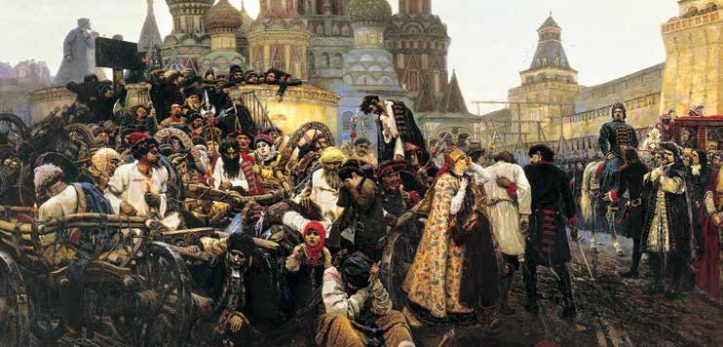Russian anti-Catholicism. Part 1
Author: Grzegorz Kucharczyk,
"Love One Another!" 35/2016

Anti-Catholicism did not appear in Russia with the Bolshevik Revolution. Traditional enmity towards “Latins” (Catholics) is far older in this country, going back to medieval Kievan Rus’.

In the middle of the twelfth century, Theodosius the Greek, hegumen (superior) of the Kiev Pechersk Lavra (monastery), wrote the treatise A Word on Christian and Latin Faiths, in which we read:
Do not join the Latin faith, do not follow their customs, run away from their [holy] communion, avoid any of their teachings, hold their conduct in contempt, do not dare to give your daughters in marriage to them, do not marry them either or fraternise with them, do not bow to them or kiss them or eat from one bowl with them or drink with them or receive any food from them.
Why did the “Second Rome” fall?
After the fall of Kievan Rus’, in the wake of the Mongol invasions in the first half of the thirteenth century, Muscovy became a major political power. In the late fifteenth century, when the rulers of Muscovy were able to throw off the “Tartar yoke”, they embraced the theory of the Third Rome, which held that Moscow was the Third Rome or the last “truly Christian” empire. According to the proponents of this theory, the First Rome, or papal Rome, fell mainly as a result of the burning ambitions of popes to rule the entire world. The Second Rome fell not only because it was captured by the Turks in 1453 and has been ruled by the Muslims since then. According to those who saw Moscow as the Third Rome, the demise of Constantinople had begun earlier. That is how they interpreted the Union of Florence of 1439 between Rome and Constantinople, which was meant to put an end to the Eastern Schism of 1054.
The Moscow Orthodox Metropolitan rejected the Union of Florence outright and opposed the position taken on this matter by the Kiev Metropolitan Isidore, who signed the document of the Union at the Council of Florence and, having been given a cardinal’s hat, left for Moscow to argue in favour of reconciliation with Rome. In return, he was imprisoned and later expelled from the country.
Uniates were universally considered traitors of the “Orthodox faith” through whom the ”Latin heresy” might penetrate further east
It must be noted that at the same time, under the slogan of “gathering Rus’ lands”, the Muscovite rulers waged several aggressive wars against Lithuania, which was joined in union with Poland. Moscow thus believed itself to be a natural successor to Kievan Rus’, the lands of which had largely fallen under the rule of the Grand Dukes of Lithuania. Considering that both Lithuania and Poland were Catholic countries and nations, this western expansion of Moscow, which believed itself to be the Third Rome, had also clear anti- Catholic implications.
The tsar to his daughter: do not listen to the Roman Church!
In the early sixteenth century, Helena, daughter of the Muscovy tsar, Ivan III, was about to marry the Grand Duke of Lithuania, the future King of Poland, Alexander I. As she was leaving Moscow, Helena was given the following advice in a letter by her father, the tsar: “Do not attend services in a Latin temple, go to a Greek Orthodox church instead; out of curiosity, you may go and see the former or a Latin monastery, but only once or twice. If your husband, while in Vilnius, tells you to accompany him to a temple, go with him as far as the door and tell him honestly that you are going to your Orthodox church.”
In 1503, when another war between Muscovy and the Jagiellon monarchy was coming to an end, worried by the rumours (fully justified as it turned out) about his daughter’s conversion to Catholicism, Ivan III wrote a dramatic letter to Helena, who was by then Queen of Poland:
Daughter! Remember God, our pedigree, our imperatives, in everything hold fast to your Greek faith and do not join the Roman faith in any way; do not listen to the Roman Church or the pope in any matter, do not attend services in a Roman church, do not pledge your soul to anybody, do not bring disgrace on me and our entire family. […] And if you have to suffer bloodshed for your faith, suffer it. And if, daughter, you join the Roman faith freely or under coercion, your soul will be lost with God and you will fall into disfavour with us.
Union with Rome is a betraya
The turn of the seventeenth century was the key period for a cluster of ideas, anti-Catholicism, anti-Polonism and anti-Latinism, which have persisted to this very day in Russian political and social traditions. Two events were of major importance in this respect: the conclusion of the so-called Union of Brest in 1595 (the rise of the Uniate Church) and the Time of Troubles in Russia.
The Union concluded in 1595 between the Orthodox Church in the Polish-Lithuanian Commonwealth and Rome (for which considerable credit was due to the Society of Jesus in Poland led by Fr Piotr Skarga) was represented by the Moscow Orthodox Church as a “pact with the devil”, with “Latin heretics” and the “servant of the Anti-Christ” (the pope). Moscow was flooded with anti-Catholic publications.
A typical example of such literature was the treatise A Brief Proclamation on Latin Temptation by Ivan Vishenskiy, a Ukrainian monk from Mount Athos. Its author set out to convince his readers that the Catholic Church was the “servant of the Anti-Christ”, which had first subjugated Poland and later wanted to seize Rus’: “If you want to be a bishop, fall to your knees and bow to me and I will grant it to you. If you want to be an archbishop, fall to your knees and bow to me and I will grant it to you. If you want to be a cardinal, fall to your knees and bow to me and I will grant it to you. If you want to be the pope, fall to your knees and bow to me and I will grant it to you.” Elsewhere, he warned how the church union with Rome would end up: “Instead of teaching the Gospel, the teachings of the Apostles and the laws of saints, as well as the restrictions of virtue and the honesty of Christian conscience, the palaces of Christ the Lord are now ruled by heathen teachers: Aristotles, Platoes and other such dissemblers and comedians.”
The expulsion of Poles from Moscow in 1612 was presented not only as a political victory over Poland but also as a spiritual and civilisational triumph over the “plague of Latinism”
The Union of Brest of 1595 and the consequent rise of the Greek Catholic (Uniate) Church in the east of the Polish-Lithuanian Commonwealth continued to be attacked by anti-Catholic propaganda in Moscow over the following centuries: Uniates were universally considered traitors of the “Orthodox faith” through whom the ”Latin heresy” might penetrate further east.
Next, the support offered by Poland to False Dmitry, followed by an attempt to install on the Moscow throne a representative of the Catholic Vasa dynasty ruling Poland (King Sigismund III or his son Władysław), was viewed as yet another attempt to bring the last “Orthodox country” under Jesuit control. The expulsion of Poles from Moscow in 1612 was presented not only as a political victory over Poland but also as a spiritual and civilisational triumph over the “plague of Latinism,” to which Poland had earlier succumbed.
The “dangerous” influences of Kiev in Moscow
Against that “plague”, Muscovy – both the State and the Church – took various measures. It is worth remembering that a strong impulse behind the reforms undertaken in the Orthodox Church by the Moscow Patriarch Nikon during the second half of the seventeenth century was his struggle against icons painted according to “Western” models (or “Polish models”).
Unacceptable “Latin influences” were also traced to the impact the Kiev-Mogila Academy had on Moscow. It was an Orthodox institution of higher education with a tradition of almost one hundred years and a thriving centre of Orthodox culture in the former capital of Kievan Rus’. The Academy was exceptional in the Orthodox world, because not only Greek but also Latin was regularly taught there. Its curricula covered the writings not only of the so-called Eastern Church Fathers, but also those forming the Western tradition. Even more surprisingly, students learned of the works of ancient philosophers (such as Aristotle), who had inspired the development of Catholic philosophy and theology in the Middle Ages (scholasticism).
Importantly, in the circle of the Kiev-Mogila Academy, certain forms of devotion were adopted that were rather typical of the Latin tradition, for instance the Eucharistic cult. In the Orthodox tradition, it was not known in the form of adorations and Eucharistic processions in which it had been practised for centuries in the Western Church and began to spread to Moscow via the Kiev-Mogila Academy during the second half of the seventeenth century.
After Kiev (since 1667) was wrenched from the Polish-Lithuanian Commonwealth and became part of Russia, the cultural impact of the Kiev-Mogila Academy on the social elites of Moscow (the boyars) was very strong indeed, due to its great appeal. So the tsarist government and the Church felt they had a duty (in the name of the struggle with the “Latin heresy”) to systematically counter that impact. In 1690, the Moscow Church Council condemned the “bread-worshipping heresy” (as the Eucharistic cult modelled on the practice of the Latin Church was called) and rejected liturgical books published in Kiev as being contaminated with the “Latin heresy.”
What did Peter I look for in the West?
In the Polish-Lithuanian Commonwealth, the golden age of the Union of Brest was the eighteenth century. At the same time, however, the Commonwealth was entering political decline, linked to the Saxon era. Russian troops, introduced by Tsar Peter I, maintained an almost permanent presence on Polish territory. In the history of Russia, Peter I is associated above all with the violent (including in the literal sense, often using a whip or knout) opening of his country to the West (so-called occidentalisation).
Yet that opening in no way meant an opening to Catholicism, despite the fact that Catholic Poland lay to the west of Russia. Peter I looked elsewhere for inspiration. During his reign, the occidentalisation of Russia meant that the court and subservient Russian intellectual elites were strongly convinced of the close spiritual affinities between the Orthodox and Protestant faiths. A similar opinion was shared by one of Peter I’s successors, Catherine II (a German by descent), who boldly claimed that there were almost no differences between the Orthodox and Lutheran faiths. The prevalence of this opinion was certainly helped by the fact that during the eighteenth century occidental influences spread in Russia mainly through Baltic-German intermediaries, which were almost exclusively Lutheran.
Peter I’s hostility towards the Uniate Church matched the hatred for Greek Catholics shown by his predecessors on the Moscow throne
The Protestant notion of State– Church relations in which the former is the dominant party while the latter is reduced to a subservient role or to the status of an established Church, in which the ruler is ex officio its head (see the Anglican Church) suited Peter I’s plans very well. His reforms provided for the complete abolition of the independent Moscow Patriarchate (it would be briefly revived after the tsarist regime was overthrown in 1917) and his proclamation as the head of the Moscow Church. It was to be ruled by a purposefully designated administrative body.
A “New Rome” on the Neva
Mention should also be made of the anti-Catholic context of Peter I’s founding of Russia’s new capital: Saint Petersburg. As Russian historians working on this question write, we are faced in this case with a new version of the anti-Catholic conception of a “new Rome”, which was supposed to dethrone the “old” (papal) Rome:
Of the two possibilities for the capital, as a centre of holiness and as a city in the shadows of imperial Rome, Peter selected the latter. The orientation towards Rome, bypassing Byzantium, naturally posed the problem of the rivalry with Catholic Rome for the right to the historical heritage. […] In this context, calling the new capital the City of Saint Peter was inevitably associated not only with the glorification of Peter I’s heavenly patron, but also with the idea of Petersburg as a New Rome. The orientation towards Rome can be seen not only in the capital’s name, but also in its coat of arms. […] The coat of arms of St Petersburg contains modified motifs from the coat of arms of the City of Rome (or the Vatican, as the successor to Rome), which of course was no mere accident (J. Lotman, B. Uspienski).
Although in many areas the reign of Tsar Peter I represented a radical break with the state traditions of the “old Moscow”, on one issue the Reformer Tsar did preserve continuity. His hostility towards the Uniate Church matched the hatred for Greek Catholics shown by his predecessors on the Moscow throne.
Crossing the eastern fringes of the Polish-Lithuanian Commonwealth with his army, the tsar, personally murdering Uniate priests (in Polotsk), set an example to his subjects of how Uniates ought to be dealt with. In 1708, when the Cossack ataman Ivan Mazepa allied himself with Charles XII of Sweden, Tsar Peter I, in his manifesto to “our faithful subjects of the Little Russian nation”, defined the purpose of this alliance as follows: “to subjugate the Little Russian lands by placing them under Polish rule and give God’s churches and monasteries to the Uniates.”
Source: https://loamagazine.org/archive/2016/2016-35/russian-anti-catholicism-part-1
The article was published with the permission from "Love One Another!" in September 2020.
Submit
your article!
Read
more articles - Free!
Need
translation jobs? Click here!
Translation
agencies are welcome to register here - Free!
Freelance
translators are welcome to register here - Free!
Subscribe
to TranslationDirectory.com newsletter - Free!
Take
part in TranslationDirectory.com poll - your voice counts!
|





